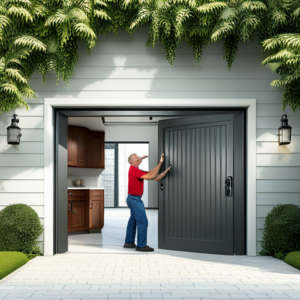ower outages can be a frustrating experience, especially when they leave you trapped inside your garage. With a little knowledge and preparation, however, you can learn how to open your garage door manually. This comprehensive guide will walk you through the process, ensuring you can safely and effectively operate your garage door during a power outage.
Essential Tools and Safety Precautions for Manual Garage Door Operation
Before attempting to open your garage door manually, it’s important to gather a few essential tools and take some necessary safety precautions. The following items will help you successfully and safely navigate the process:
- Work gloves: Wearing work gloves will protect your hands from potential injuries while handling your garage door.
- A ladder: You’ll need a ladder to reach the garage door opener and its various components.
- A flashlight: In the event of a power outage, a flashlight will provide the necessary light to see what you’re doing.
- Proper footwear: Wear closed-toe shoes to protect your feet from potential injuries.
In addition to gathering these essential tools, you should also take the following safety precautions:
- Clear the area: Remove any items or obstructions around the garage door to ensure a safe workspace.
- Turn off the garage door opener: Unplug the opener from its power source to prevent it from accidentally engaging during the manual operation process.
- Be cautious: Remember that garage doors can be heavy and may require some strength to lift. Be prepared to exert some effort when manually opening the door.
How to Disengage Your Garage Door Opener
To open your garage door manually, the first step is to disengage your garage door opener. This will allow you to manually lift and lower the door without the assistance of the opener’s motor. Follow these steps to disengage your garage door opener:
- Locate the emergency release cord: The emergency release cord is typically a red rope with a handle hanging from the garage door opener’s trolley. This trolley is connected to the garage door and moves along the track as the door opens and closes.
- Pull the emergency release cord: Grasp the handle and pull the cord down and away from the door. This will disengage the trolley from the opener, allowing you to manually operate the door.
- Test the door: Gently lift the garage door to ensure it has been properly disengaged. The door should move freely without resistance from the opener.
Step-by-Step Guide: How to Manually Open Your Garage Door
Now that your garage door opener is disengaged, you’re ready to open the garage door manually. Follow these steps to safely and effectively lift your garage door:
- Ensure the door is unlocked: Check that the lock on your garage door is disengaged. Some doors have manual locks that must be unlocked before the door can be opened.
- Lift the door: Grasp the door’s handle or bottom edge firmly with both hands. Lift the door slowly and steadily, using your legs to help support the weight. Be prepared for the door to feel heavy, as you are now lifting the full weight of the door without the assistance of the opener.
- Secure the door in the open position: Once the door is fully open, use a vice grip or a pair of locking pliers to secure the door in place. Attach the vice grip to the track just below one of the door rollers, ensuring it’s tight enough to hold the door in the open position.
You can check out Wiki How article about the same topic as well as on the garage door tips.
Troubleshooting Common Manual Garage Door Issues
Sometimes, you may encounter issues when attempting to open your garage door manually. Here are some common problems and their solutions:
- The door is too heavy to lift: If the door feels too heavy or difficult to lift, it’s possible that the garage door springs have become damaged or broken. These springs counterbalance the weight of the door and assist in the lifting process. If the springs are damaged, it’s best to call a professional to assess and repair the issue.
- The door won’t stay open: If your garage door won’t stay open when lifted, the door’s balance may be off. This can be caused by a variety of issues, including worn or damaged springs, rollers, or cables. Contact a professional to diagnose and resolve the problem.
- The door is jammed: If your garage door is jammed and won’t move, there may be an obstruction in the track or the track may be misaligned. Inspect the track for any debris or damage, and contact a professional if necessary to address the issue.
How to Reengage Your Garage Door Opener After Power Restoration
Once power has been restored, you’ll need to reengage your garage door opener to resume normal operation. Follow these steps to reconnect your opener and garage door:
- Close the garage door: If your garage door is open, manually lower it to the closed position.
- Reconnect the opener: Pull the emergency release cord towards the door to reengage the trolley. You should hear a click when the trolley reconnects with the opener.
- Test the opener: Use your garage door opener’s remote or wall control to open and close the door, ensuring it’s functioning properly.
When to Call a Professional for Garage Door Assistance
While this guide can help you successfully open your garage door manually during a power outage, there are some instances when it’s best to call a professional for assistance. If you encounter any of the following issues, don’t hesitate to contact a garage door expert:
- Damaged or broken springs, rollers, or cables
- A jammed or misaligned track
- An opener that won’t reengage after power restoration
- Any other concerns or issues beyond your comfort level or expertise
Mastering the art of opening your garage door manually during a power outage is an important skill to have. By following this comprehensive guide and understanding when to call a professional for assistance, you’ll be well-prepared to navigate any power outage with ease and confidence.


